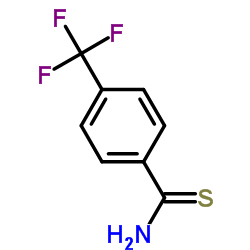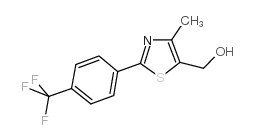4-Methyl-2-4-(trifluoromethyl)phenyl]thiazole-5-carboxylic acid
![4-Methyl-2-4-(trifluoromethyl)phenyl]thiazole-5-carboxylic acid Structure](https://image.chemsrc.com/caspic/084/144059-86-9.png)
4-Methyl-2-4-(trifluoromethyl)phenyl]thiazole-5-carboxylic acid structure
|
Common Name | 4-Methyl-2-4-(trifluoromethyl)phenyl]thiazole-5-carboxylic acid | ||
|---|---|---|---|---|
| CAS Number | 144059-86-9 | Molecular Weight | 287.25800 | |
| Density | 1.438g/cm3 | Boiling Point | 413.2ºC at 760mmHg | |
| Molecular Formula | C12H8F3NO2S | Melting Point | 237 °C | |
| MSDS | N/A | Flash Point | 203.7ºC | |
Use of 4-Methyl-2-4-(trifluoromethyl)phenyl]thiazole-5-carboxylic acid4-Methyl-2-[4-(trifluoromethyl)phenyl]-1,3-thiazole-5-carboxylic acid is a metabolite of GW 501516 (HY-10838) [1]. |
| Name | 4-Methyl-2-[4-(TRIFLUOROMethyl)Phenyl]Thiazole-5-Carboxylic Acid |
|---|---|
| Synonym | More Synonyms |
| Description | 4-Methyl-2-[4-(trifluoromethyl)phenyl]-1,3-thiazole-5-carboxylic acid is a metabolite of GW 501516 (HY-10838) [1]. |
|---|---|
| Related Catalog | |
| References |
| Density | 1.438g/cm3 |
|---|---|
| Boiling Point | 413.2ºC at 760mmHg |
| Melting Point | 237 °C |
| Molecular Formula | C12H8F3NO2S |
| Molecular Weight | 287.25800 |
| Flash Point | 203.7ºC |
| Exact Mass | 287.02300 |
| PSA | 78.43000 |
| LogP | 3.83550 |
| Vapour Pressure | 1.44E-07mmHg at 25°C |
| Index of Refraction | 1.554 |
Synonym: Section 2 - COMPOSITION, INFORMATION ON INGREDIENTS
Risk Phrases: 36/37/38 Section 3 - HAZARDS IDENTIFICATION EMERGENCY OVERVIEW
Irritating to eyes, respiratory system and skin. Potential Health Effects Eye: Causes eye irritation. Skin: Causes skin irritation. May be harmful if absorbed through the skin. Ingestion: May cause irritation of the digestive tract. May be harmful if swallowed. Inhalation: Causes respiratory tract irritation. May be harmful if inhaled. Chronic: Not available. Section 4 - FIRST AID MEASURES Eyes: Flush eyes with plenty of water for at least 15 minutes, occasionally lifting the upper and lower eyelids. Get medical aid. Skin: Get medical aid. Flush skin with plenty of water for at least 15 minutes while removing contaminated clothing and shoes. Ingestion: Get medical aid. Wash mouth out with water. Inhalation: Remove from exposure and move to fresh air immediately. If not breathing, give artificial respiration. If breathing is difficult, give oxygen. Get medical aid. Notes to Physician: Treat symptomatically and supportively. Section 5 - FIRE FIGHTING MEASURES General Information: As in any fire, wear a self-contained breathing apparatus in pressure-demand, MSHA/NIOSH (approved or equivalent), and full protective gear. Extinguishing Media: Use water spray, dry chemical, carbon dioxide, or chemical foam. Section 6 - ACCIDENTAL RELEASE MEASURES General Information: Use proper personal protective equipment as indicated in Section 8. Spills/Leaks: Vacuum or sweep up material and place into a suitable disposal container. Section 7 - HANDLING and STORAGE Handling: Avoid breathing dust, vapor, mist, or gas. Avoid contact with skin and eyes. Storage: Store in a cool, dry place. Store in a tightly closed container. Section 8 - EXPOSURE CONTROLS, PERSONAL PROTECTION Engineering Controls: Facilities storing or utilizing this material should be equipped with an eyewash facility and a safety shower. Use adequate ventilation to keep airborne concentrations low. Exposure Limits CAS# 144059-86-9: Personal Protective Equipment Eyes: Not available. Skin: Wear appropriate protective gloves to prevent skin exposure. Clothing: Wear appropriate protective clothing to prevent skin exposure. Respirators: Follow the OSHA respirator regulations found in 29 CFR 1910.134 or European Standard EN 149. Use a NIOSH/MSHA or European Standard EN 149 approved respirator if exposure limits are exceeded or if irritation or other symptoms are experienced. Section 9 - PHYSICAL AND CHEMICAL PROPERTIES Physical State: Solid Color: white crystalline solid Odor: Not available. pH: Not available. Vapor Pressure: Not available. Viscosity: Not available. Boiling Point: Not available. Freezing/Melting Point: 238 - 241 deg C Autoignition Temperature: Not available. Flash Point: Not available. Explosion Limits, lower: Not available. Explosion Limits, upper: Not available. Decomposition Temperature: Solubility in water: Specific Gravity/Density: Molecular Formula: C12H8F3NO2S Molecular Weight: 287 Section 10 - STABILITY AND REACTIVITY Chemical Stability: Not available. Conditions to Avoid: Incompatible materials. Incompatibilities with Other Materials: Oxidizing agents, reducing agents, bases, amines. Hazardous Decomposition Products: Hydrogen cyanide, nitrogen oxides, carbon monoxide, oxides of sulfur, carbon dioxide, fluorine, hydrogen fluoride gas. Hazardous Polymerization: Has not been reported Section 11 - TOXICOLOGICAL INFORMATION RTECS#: CAS# 144059-86-9 unlisted. LD50/LC50: Not available. Carcinogenicity: 4-Methyl-2-[4-(trifluoromethyl)phenyl]-1,3-thiazole-5-carboxylic acid - Not listed by ACGIH, IARC, or NTP. Section 12 - ECOLOGICAL INFORMATION Section 13 - DISPOSAL CONSIDERATIONS Dispose of in a manner consistent with federal, state, and local regulations. Section 14 - TRANSPORT INFORMATION IATA No information available. IMO No information available. RID/ADR No information available. Section 15 - REGULATORY INFORMATION European/International Regulations European Labeling in Accordance with EC Directives Hazard Symbols: XI Risk Phrases: R 36/37/38 Irritating to eyes, respiratory system and skin. Safety Phrases: S 26 In case of contact with eyes, rinse immediately with plenty of water and seek medical advice. S 37/39 Wear suitable gloves and eye/face protection. WGK (Water Danger/Protection) CAS# 144059-86-9: No information available. Canada None of the chemicals in this product are listed on the DSL/NDSL list. CAS# 144059-86-9 is not listed on Canada's Ingredient Disclosure List. US FEDERAL TSCA CAS# 144059-86-9 is not listed on the TSCA inventory. It is for research and development use only. SECTION 16 - ADDITIONAL INFORMATION N/A |
| Hazard Codes | Xi: Irritant; |
|---|---|
| Risk Phrases | R36/37/38 |
| Safety Phrases | S22-S36/37/39 |
| HS Code | 2934100090 |
|
~86% ![4-Methyl-2-4-(trifluoromethyl)phenyl]thiazole-5-carboxylic acid Structure](https://image.chemsrc.com/caspic/084/144059-86-9.png)
4-Methyl-2-4-(t... CAS#:144059-86-9 |
| Literature: Sierra, Michael L.; Beneton, Veronique; Boullay, Anne-Benedict; Boyer, Thierry; Brewster, Andrew G.; Donche, Frederic; Forest, Marie-Claire; Fouchet, Marie-Helene; Gellibert, Francoise J.; Grillot, Didier A.; Lambert, Millard H.; Laroze, Alain; Le Grumelec, Christelle; Linget, Jean Michel; Montana, Valerie G.; Nguyen, Van-Loc; Nicodeme, Edwige; Patel, Vipul; Penfornis, Annie; Pineau, Olivier; Pohin, Danig; Potvain, Florent; Poulain, Geraldine; Ruault, Cecile Bertho; Saunders, Michael; Toum, Jerome; Xu, H. Eric; Xu, Robert X.; Pianetti, Pascal M. Journal of Medicinal Chemistry, 2007 , vol. 50, # 4 p. 685 - 695 |
|
~% ![4-Methyl-2-4-(trifluoromethyl)phenyl]thiazole-5-carboxylic acid Structure](https://image.chemsrc.com/caspic/084/144059-86-9.png)
4-Methyl-2-4-(t... CAS#:144059-86-9 |
| Literature: WO2004/785 A2, ; Page 20 ; WO 2004/000785 A2 |
|
~% ![4-Methyl-2-4-(trifluoromethyl)phenyl]thiazole-5-carboxylic acid Structure](https://image.chemsrc.com/caspic/084/144059-86-9.png)
4-Methyl-2-4-(t... CAS#:144059-86-9 |
| Literature: Journal of Medicinal Chemistry, , vol. 50, # 4 p. 685 - 695 |
| HS Code | 2934100090 |
|---|---|
| Summary | 2934100090 other compounds containing an unfused thiazole ring (whether or not hydrogenated) in the structure VAT:17.0% Tax rebate rate:9.0% Supervision conditions:none MFN tariff:6.5% General tariff:20.0% |
| MFCD00068105 |
| 4-Methyl-2-[4-(trifluoromethyl)phenyl]-1,3-thiazole-5-carboxylic acid |
| 4-Methyl-2-(4-(trifluoromethyl)phenyl)thiazole-5-carboxylic acid |
![Ethyl 4-methyl-2-[4-(trifluoromethyl)phenyl]-1,3-thiazole-5-carboxylate structure](https://image.chemsrc.com/caspic/329/175277-03-9.png)

 CAS#:317318-96-0
CAS#:317318-96-0![4-methyl-2-[4-(trifluoromethyl)phenyl]-1,3-thiazole-5-carbonyl chloride structure](https://image.chemsrc.com/caspic/132/477291-09-1.png) CAS#:477291-09-1
CAS#:477291-09-1